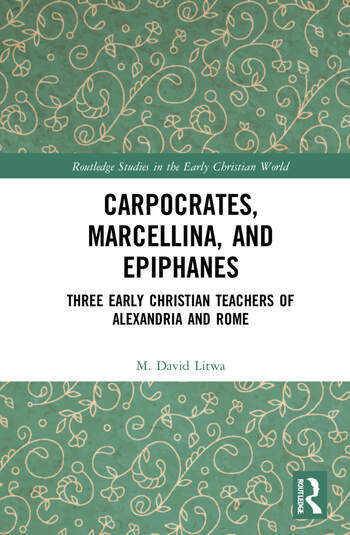Who was Carpocrates? Most early Christian writers depicted him as the founder of a licentious cult, a magician, and a practitioner of “pagan” rites. They said that his followers practiced indiscriminate sex at their communal dinners. Carpocrates, said his opponents, demanded that his followers engage in every sin before they could break the cycle of transmigration and rise to the supreme Father. Since 1958, Carpocrates has also been accused of stealing, interpolating, and corrupting Christian scripture (a version of the gospel according to Mark). Scholarly treatments of the past century portray Carpocrates as a Platonic philosopher, a “Jewish Christian,” a gnostic, a promoter of free love, and even as a mythical figure who never existed.
My new study Carpocrates, Marcellina, and Epiphanes reveals Carpocrates as a real person of the past, a Christian theologian, and a pioneer of melding biblical exegesis with philosophical lore. He and his followers were apparently not ascetic, but neither were they were “libertine.” Although Carpocrates would probably have denied practicing “magic” (a crime under Roman law), he and his followers may well have embraced miracles, divinatory practices, and the invoking of lower (angelic) powers.
Our best access to Carpocratian Christianity is not through the reports of those who attacked it, but through the only surviving fragment of an actual Carpocratian—Carpocrates’ son Epiphanes. Epiphanes was only seventeen when he died, and his father honored his dead son as a god—a divine soul who alighted briefly into a human body to benefit humanity. Epiphanes was writing philosophical treatises in his mid-teens, and a fragment of one of them—On Justice—survives.
In this treatise, Epiphanes presents the first robust theory of Christian communism based on divine law. He prefers Plato to Moses in arguing that Christian males should not own property—including their wives. It is humans who introduce laws and regulations which destroy the divine law of absolute equality between men and women, people and animals.
The Carpocratian understanding of a just, pure, and passionless Jesus, combined with their striving to imitate him, contradicts rumors of their licentious practices. For these practices, heresy writers seem to have had no evidence apart from rumors—rumors that were more often spoken against all Christians (for instance, group orgies under cover of darkness). Like Jesus, Carpocratians strove to rid themselves of passions in order to match the justice and purity of Jesus.
Heresy writers accused Carpocratians of moral relativism and indifference. Yet the only Carpocratian whose writings we know (Epiphanes) exhorted his readers to follow an objective and universal law of nature. Carpocratians considered certain phenomena to be evil—for instance, injustice and the passions. They seem to have gained a reputation for antinomianism based on their rejection of human conventions. The only specific law code mentioned, however, is the law of Moses, which Jesus was said to have despised, and which Epiphanes called, at least with regard to the Tenth Commandment (Exod 20:17), “comical.” Yet the (selective) rejection of the Mosaic law, at least in terms of practice, was common among early Christians.
In the late 150s or early 160s CE, Carpocrates’s follower Marcellina established a Christian conventicle in Rome with its own distinctive baptismal rite and worship practices. It is the only known Roman Christian group in the second century to have been led entirely by a woman (so much for women “must be silent,” 1 Timothy 2:12).
If Irenaeus derived Carpocratian writings from Marcellina’s group, then Marcellina may be the author of the allegory based on a mixture of Matthew 5:25-26 and Luke 12:58-59 (that angelic figures managed a system of transmigration until people paid “the last penny”). Transmigration was a widely known doctrine in antiquity. It was a teaching promoted by other Christian Platonists (Basilideans, Naassenes, Sethians). Marcellina disagreed with Plato, who wrote that philosophic (that is, pure) souls require at least three incarnations to break out of the cycle of transmigration (Phaedrus 249a). She opined that one could break out of the system in a single advent, an accomplishment modeled by Jesus himself.
Marcellina’s higher initiates may have been dubbed “firebrands of hearing” and “gnostics” (which is to say, knowers of spiritual truths) who received—perhaps from Marcellina herself—a brand mark behind the lobe of their right ear. Marcellina was thus not only a teacher but an initiator with distinctive Christian rites and practices.
Marcellina was probably an innovator in early Christian iconography. In her time, images of Christ as a philosopher were rare, if they existed at all. Marcellina is the only named Carpocratian who set up an image of Jesus among other philosophers (Pythagoras, Plato, and perhaps Aristotle). She believed that Jesus’ image—evidently a painted picture or statue—went back to an archetype made in the time of Pilate. For Marcellina, artistic accuracy was important. The image of Jesus was thought to resemble his physical face. This emphasis on accuracy indicates that for Carpocratians the flesh of Jesus had at least some importance. If Carpocratians only believed in the salvation of the soul, they still worshiped the embodied image of Christ.
The work typically called Secret Mark refers to a letter claiming that “Mark” wrote a more mystical Gospel, a Gospel supposedly corrupted and published anew by Carpocrates. Secret Mark probably depends on third or fourth-century traditions which portray Mark as not only a gospel-writer but as the first evangelist of Alexandria. If Secret Mark is not a 20th century hoax, then it may be a late antique forgery which paints the same kind of portrait of Carpocrates (the licentious gnostic) we see in heresy reports.
Whether one accepts Secret Mark or not, one should strive to critically read the sources in order to transcend typically dismissive and canned heresy reports. Whatever one thinks of the Carpocratians, they were an important if experimental Christian group that flourished in the second century—and the influence of their ideas and practices has still not perished from the earth.
Carpocrates, Marcellina, and Epiphanes has a companion course online, which you can access here.
